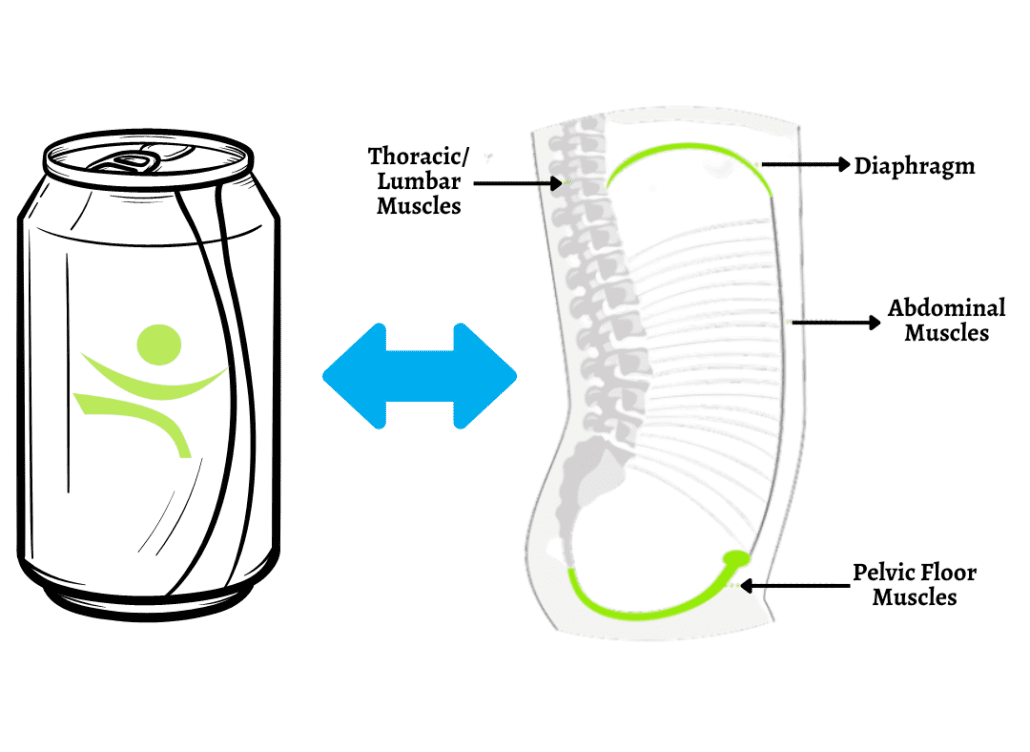WHAT CAUSES A HEAVINESS IN THE PELVIC FLOOR?
I like to explain the pelvic-abdominal region as a canister or a pop can. The pelvic floor muscles within the pelvis make up the bottom of the can, the diaphragm within the rib cage is the top of the can, and the abdominal and back muscles make up the walls. Similar to a pop can, our pelvic-abdominal canister depends on proper stability of all of its borders (pelvic floor, diaphragm, core muscles), along with a balancing of the pressure system within (pelvic and abdominal organs), to allow for proper functioning.

One symptom that can occur if our pressure system is not maintained well enough is heaviness in the pelvis. As you can guess, the direct cause of the heaviness can be due to a multitude of factors.
To break it down, heaviness at the pelvic floor (bottom of the can) would likely be due to:
- Weakness or lack of stability at the bottom of the can (pelvic floor)
- Increased pressures from above pushing down (pelvic/abdominal organs, diaphragm, core)
- Congestion within the can (think of the pressure increase that occurs after shaking or freezing a pop can)
Weakness or lack of stability:
Pelvic floor weakness can be present BOTH with hypertonic (increased activity) or hypotonic (decreased activity) pelvic floor muscles. Either the muscles aren’t working enough to provide stability, or they are trying to work ALL THE TIME and are no longer efficient. In each of these states, the pelvic floor is not able to properly support the pressures from above. This could lead to bladder and bowel dysfunction, pelvic pain, AND the sensation of pelvic heaviness.
Increased pressure from above:
One common example of this is pelvic organ prolapse (POP). Prevalence of POP has been found to be as high as 50% based on gynecological assessment, though prevalence drops significantly based on symptomology.[1] Pelvic organ prolapse occurs when there is a weakening of the fascia, connective tissues, and ligaments that support the pelvic organs (bladder, rectum, uterus). Symptoms may consist of urinary, bowel, and sexual difficulties, along with a common complaint of heaviness or pressure within the vagina. Prolapse can be graded into four different grades (1 to 4) based on the degree of organ descent within the vaginal cavity, though symptoms don’t always correlate with the severity of descent.
Congestion:
Congestion within the pelvis could come from digestive gases or stool due to GI upset or constipation. It could also stem from a venous insufficiency known as pelvic congestion syndrome (PCS). PCS is defined as the presence of pelvic or ovarian varicose veins associated with pelvic pain persisting for 6 months or longer. 30-40% of chronic pelvic pain cases are associated with pelvic congestion syndrome.[1] Low back pain and pelvic heaviness are common symptoms associated with PCS and the symptoms tend to be exacerbated by standing, intercourse, and menstruation.
It can sometimes be tough to determine the primary cause of a symptom such as “heaviness in the pelvis,” but one can get to the bottom of it with the help of medical professionals. Sometimes all it calls for is some retraining of your pelvic floor muscles and balancing of the tissues that make up your pelvic-abdominal canister.
If your tissues are in coordination and balance with each other, then internal pressures are neutralized and your “canister” is as strong and stable as a full, closed, non-shaken can of pop!
[1] https://www.thieme-connect.com/products/ejournals/html/10.1055/s-0038-1636519
